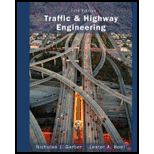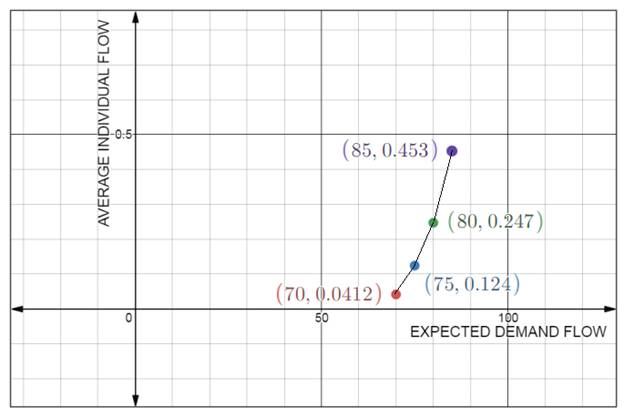
Concept explainers
(a)
The maximum queue length that will be formed, total delay, number of vehicles that will be affected by the incident, the average individual delay for the expected demand flow of 70%of the capacity of the highway.
Answer to Problem 20P
For 70 % expected demand flow:
Themaximum queue length that will be formed is
The total delay is
The number of vehicles that will be affected by the incident is
The average individual delay is
Explanation of Solution
Given:
We have been given the following information:
Total number of lanes = 3,
Mean free flow speed of the highway
Jam density
Following is the lay out of the given highway section:

Calculation:
For the expected 70 % demand flow:
We have the following formula for the determination of maximum queue length that will be formed:
Where,
Considering 70 percent of the flow and that the capacity of each lane is 2000 Veh/ h
Substituting the values in the following equation, we have
The maximum queue length that will be formed is
Now, the total delay, we have the following formula
Where,
And C is the total capacity and can be found as
Now, substituting the values in the required equation, we have
The total delay is
The number of vehicles that will be affected by the incident.
To calculate the number of vehicles that will be affected by the incident can be found using the following formula:
Number of vehicles affected =
Substituting the values, we have
The number of vehicles that will be affected by the incident is
To calculate the average individual delay, we have the following formula:
Average individual delay
Substituting the values, we have
The average individual delay is
Conclusion:
Therefore, for 70 % expected demand flow:
Themaximum queue length that will be formed is
The number of vehicles that will be affected by the incident is
(b)
The maximum queue length that will be formed, total delay, number of vehicles that will be affected by the incident, the average individual delay for the expected demand flow of 75%of the capacity of the highway.
Answer to Problem 20P
For 75 % expected demand flow:
Themaximum queue length that will be formed is
The total delay is
The number of vehicles that will be affected by the incident is
The average individual delay is
Explanation of Solution
Given:
We have been given the following information:
Total number of lanes = 3,
Mean free flow speed of the highway
Jam density
Following is the lay out of the given highway section:

Calculation:
For the expected 75 % demand flow:
We have the following formula for the determination of maximum queue length that will be formed:
Where,
Considering 75 percent of the flow and that the capacity of each lane is 2000 Veh/ h
Substituting the values in the following equation, we have
Themaximum queue length that will be formed is
Now, the total delay, we have the following formula
Where,
And C is the total capacity and can be found as
Now, substituting the values in the required equation, we have
The total delay is
The number of vehicles that will be affected by the incident.
To calculate the number of vehicles that will be affected by the incident can be found using the following formula:
Number of vehicles affected =
Substituting the values, we have
The number of vehicles that will be affected by the incident is
To calculate the average individual delay, we have the following formula:
Average individual delay
Substituting the values, we have
The average individual delay is
Conclusion:
For 75 % expected demand flow:
Themaximum queue length that will be formed is
(c)
The maximum queue length that will be formed, total delay, number of vehicles that will be affected by the incident, the average individual delay for the expected demand flow of 80% of the capacity of the highway.
Answer to Problem 20P
For 80 % expected demand flow:
Themaximum queue length that will be formed is
The total delay is
The number of vehicles that will be affected by the incident is
The average individual delay is
Explanation of Solution
Given:
We have been given the following information:
Total number of lanes = 3,
Mean free flow speed of the highway
Jam density
Following is the lay out of the given highway section:

Calculation:
For the expected 80 % demand flow:
We have the following formula for the determination of maximum queue length that will be formed:
Where,
Considering 80 percent of the flow and that the capacity of each lane is 2000 Veh/ h
Substituting the values in the following equation, we have
The maximum queue length that will be formed is
Now, the total delay, we have the following formula
Where,
And C is the total capacity and can be found as
Now, substituting the values in the required equation, we have
The total delay is
The number of vehicles that will be affected by the incident.
To calculate the number of vehicles that will be affected by the incident can be found using the following formula:
Number of vehicles affected =
Substituting the values, we have
Therefore, the number of vehicles that will be affected by the incident is
To calculate the average individual delay, we have the following formula:
Average individual delay
Substituting the values, we have
The average individual delay is
Conclusion:
For 80 % expected demand flow:
Themaximum queue length that will be formed is
the average individual delay is
(d)
The maximum queue length that will be formed, total delay, number of vehicles that will be affected by the incident, the average individual delay for the expected demand flowof 85% of the capacity of the highway.
Answer to Problem 20P
For 85 % expected demand flow:
Themaximum queue length that will be formed is
The total delay is
The number of vehicles that will be affected by the incident is
The average individual delay is
Explanation of Solution
Given:
We have been given the following information:
Total number of lanes = 3,
Mean free flow speed of the highway
Jam density
Following is the lay out of the given highway section:

Calculation:
For the expected 85 % demand flow:
We have the following formula for the determination of maximum queue length that will be formed:
Where,
Considering 85 percent of the flow and that the capacity of each lane is 2000 Veh/ h
Substituting the values in the following equation, we have
Therefore, the maximum queue length that will be formed is
Now, the total delay, we have the following formula
Where,
And C is the total capacity and can be found as
Now, substituting the values in the required equation, we have
Therefore, the total delay is
The number of vehicles that will be affected by the incident.
To calculate the number of vehicles that will be affected by the incident can be found using the following formula:
Number of vehicles affected =
Substituting the values, we have
The number of vehicles that will be affected by the incident is
To calculate the average individual delay, we have the following formula:
Average individual delay
Substituting the values, we have
the average individual delay is
The graph of average individual delay versus the expected demand flow is as follows:

Conclusion:
For 85 % expected demand flow:
Themaximum queue length that will be formed is
the average individual delay is
Want to see more full solutions like this?
Chapter 6 Solutions
Traffic And Highway Engineering
- Send me the solution to the following question based on the source and I do not want the solution from artificial intelligencearrow_forwardQ5: Find the force in each member of truss in figure below. 10 kN -2 m- 4 m 2 m 5 kN 4 m 45arrow_forwardSend me the solution to the following question based on the source and I do not want the solution from artificial intelligencearrow_forward
- Send me the solution to the following question based on the source and I do not want the solution from artificial intelligencearrow_forwardSend me the solution to the following question based on the source and I do not want the solution from artificial intelligencearrow_forwardSTRUCTURES I Homework #1: Force Systems Name: TA: PROBLEM 1 Determine the horizontal and vertical components of the force in the cable shown. PROBLEM 2 The horizontal component of force F is 30 lb. What is the magnitude of force F? 6 10 4 4 F = 600lbs F = ?arrow_forward
- 18:02 28% 50 同 こ 【Recommend】 Easily add text in PDF 3 m 35 kN 4m 84 kN +3m EA = constant E = 200 GPa A T5 4m Add 1,200 mm² Find Horizontal and vertical displacement at B 4 kN m m- B Determine Vertical displacement at C Determine the displacement or point B of the steel beam shown in Take E200 GPa, I = 500(106) mm4. 5 m 2/ 40 kN B 12 kN/m 4 m. 12 kN/m 3 m B 10 m- E constant = 70 GPa I 554 (10) mm Determine Displacement at C ΙΣΤ Edit Annotate Fill & Sign Convert Allarrow_forwardIn a floor of an industrial building, boilers are supported symmetrically on secondary beams A and B, which have a centre-to-centre distance of 5 m and which are in turn supported by the main beam, which has a span of 9 m (see Fig. 10.62). Design the main beam given the following data:arrow_forwardS₂ S S,-40 S,-100 P S,=40 40 80 80 40arrow_forward
- The bolted connection shown is connected with M20 bolts in standard holes. The plate material is A36 steel. Find the allowable (ASD) tensile strength of each plate. 50 65 65 65 13 40 65 40 13arrow_forwardA 3.048 m long column (Fy = 483 MPa) carries an axial compression load of 5000 kN dead load. The column is braced at mid-height to strengthen the column in the weak direction. Use LRFD. Which of the following most nearly gives the nominal compressive strength? Show solution and drawingsarrow_forwardWhen an open-ended square tube is placed vertically into a pool of water, the water rises 4 mm up inside of the tube. A) Determine the inner length of the square tube. A solid cylindrical rod is then placed vertically down the center of the open-ended square tube and the water rises an additional 4 mm up the tube. B) Determine the diameter of the solid rod that was inserted. 0.073 @ 20N m T C s = = o .arrow_forward
 Traffic and Highway EngineeringCivil EngineeringISBN:9781305156241Author:Garber, Nicholas J.Publisher:Cengage Learning
Traffic and Highway EngineeringCivil EngineeringISBN:9781305156241Author:Garber, Nicholas J.Publisher:Cengage Learning
